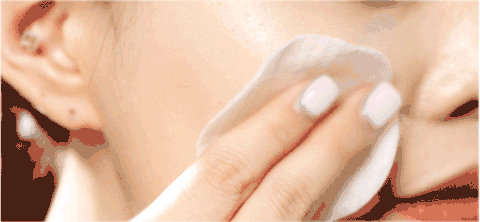So you’ve read up on skincare acids, know your glycolic from your mandelic, and feel informed enough to take the plunge. But wait! There’s still more you need to do before you dive face-first into chemical exfoliation. Make sure you do these 5 things as you prepare to use acids so that you get the glow you deserve.
So you’ve read my primer on chemical exfoliation (part 1 and 2) and my friend Cat’s deep dive into skincare acids, and you feel ready to try some (effectively formulated) acids of your own. Stop right there! Before you start putting acids on your face, make sure you’re adequately prepared. And I’m not talking about pH-balancing acid prep toners, either, because I don’t really believe in the need for those. No, I’m talking about making sure your skin condition and skincare routine are ready to handle chemical exfoliation.
1. Beef up your barrier
Quick refresher: The outermost layer of our skin, the stratum corneum or “horny layer,” is made up of flattened dead skin cells and naturally occurring lipids laid out in a brick-and-mortar structure. The horny layer keeps moisture in our skin and keeps bacteria and other irritants and contaminants out. Exfoliation, whether chemical or physical, removes some of those dead skin cells from the horny layer, revealing the smoother, brighter, fresher, and often clearer skin underneath.

Some exfoliation is a great thing. As you can imagine, however, exfoliation thins the horny layer as you slough off those dead skin cells. If you thin it too much, you end up with over-exfoliated skin, and fixing over-exfoliated skin can be a pain.
One of the best ways to prevent over-exfoliation is to make sure your barrier is in prime condition before you begin using acids. For at least a couple of weeks before you start chemical exfoliants, discontinue any other exfoliation. No scrubs, no rough washcloths. Not even a peeling gel. Switch to a low pH cleanser if you haven’t already. Discontinue use of retinoids if you’re using any of those. Spend those two weeks babying your skin. A stronger barrier will reduce your risk of over-exfoliation.
2. Plan to take it slow
Even with a fairly gentle, daily use type chemical exfoliant like COSRX AHA 7 Whitehead Power Liquid, there’s a learning curve. Some people have tough, hardy skin that can tolerate a ton of acids. Other people will find that their skin can’t take even a milder product more than a couple of times a week. Which category do you fall into? You won’t know until you try.

For this reason, plan to take it slow and easy with the acids at first. Only use them a couple of times a week for the first couple of weeks to see how well your skin tolerates them. If your skin still seems fine after that, increase the frequency to every other day and see how that goes. If that continues to feel OK, you can go ahead and start using them every day. Pull back if your skin starts to look or feel thin, sensitive, or irritated, and only add your other strong actives back in once you’ve established your tolerance.
3. Have your sunscreen game locked down
Acids, AHAs in particular, are photosensitizing. The fresh new skin that chemical exfoliation reveals is much less protected against UV damage and much more prone to sunburns and hyperpigmentation. For this reason, you really need to have established great sunscreen habits before you start.
Look for a sunscreen that is light and clear enough to apply very generously, and comfortable and affordable enough to apply very generously every single day, regardless of the weather or season. Generous application is critical. Sunscreen protection is measured by applying 2mg/cm2 of product to skin. This works out to about ¼ tsp.
My recent #threefingers sunscreen application video demonstrates how I get that much product on my face at once. Using less than a generous amount of sunscreen will dramatically reduce your protection.
View this post on Instagram
4. Patch test!
Now you’ve got your acids in hand. But don’t start slathering them full-face just yet.
Any unfamiliar product brings the risk of irritation or reactions, particularly for more sensitive skin, and if you’re fairly new to the skincare game, you may also have a limited knowledge of what ingredients or product types might bother your skin. For these reasons, it’s best to patch test any new products before diving into them face-first.
Choose a small and fairly inconspicuous part of your face to patch test on. Personally, I like the bit of skin right next to my ear. If something goes wrong, I can mostly hide that part with my hair and pretend it isn’t there. Patch test by using the new product just on that area for a few consecutive nights. This way, you can see if your skin will react poorly to it. If it doesn’t, you’re good to go for full-face use!
![]()
5. Take before photos and schedule progress photo shoots, too
One of the hardest things about skincare is waiting patiently to see results. Very few products deliver instantly visible effects, and the weeks that may pass before we really notice a change in our skin can be discouraging. This is especially true because we see our faces in the mirror every day, and our brains aren’t great at registering incremental changes: Our skin may be slowly improving, but to our own eyes, we look exactly the same.
Feeling that we aren’t getting results can be not only discouraging but disastrous. It’s common to be tempted to slap on stronger and stronger acids because we don’t think what we’re using is working, only to end up with a compromised barrier and worse skin condition than before.
To stave off this effect, plan to take progress photos. Find someplace in your house where you can get good, consistent lighting. Take a before photo with no makeup. Then set yourself a reminder to take a progress photo in two weeks or a month, in the same location, with the same lighting, and using the same pose. Consistency of lighting and background are key here so that differences in those factors don’t throw off your perception of your results.

Progress photos are an amazing way to stay motivated. Changes that we don’t see day to day become clear when viewing progress photos. Use those as your evidence that your routine is working (or not), rather than your reflection in the mirror. Your skin will thank you for it!
And that’s it! Now you should be ready to start acids and reveal that fresher, clearer skin that few things besides chemical exfoliation can provide.
What other things would you tell someone as they prepare to use acids? How was your experience in the beginning? Tell us your story in the comments!
Loading...